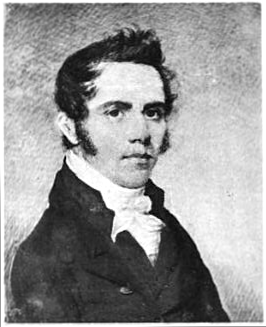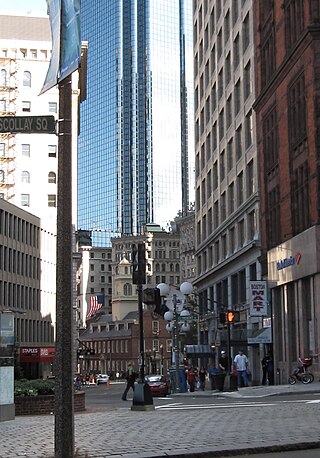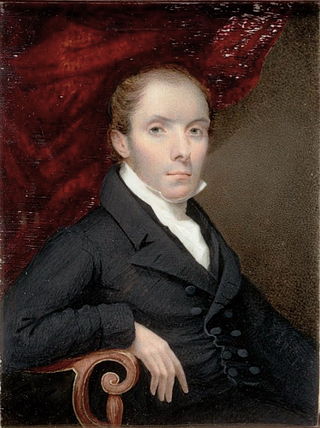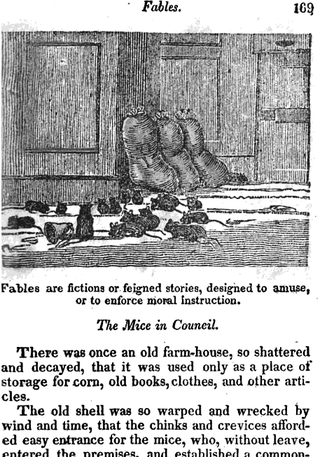
Annin & Smith (c. 1818-1837) was an engraving firm in Boston, Massachusetts, in the 19th century, established by William B. Annin and George Girdler Smith. [1] [2] [3] The firm kept offices on Court Street [4] and Cornhill. [5]

Annin & Smith (c. 1818-1837) was an engraving firm in Boston, Massachusetts, in the 19th century, established by William B. Annin and George Girdler Smith. [1] [2] [3] The firm kept offices on Court Street [4] and Cornhill. [5]

Asher Benjamin was an American architect and author whose work transitioned between Federal architecture and the later Greek Revival architecture. His seven handbooks on design deeply influenced the look of cities and towns throughout New England until the Civil War. Builders also copied his plans in the Midwest and in the South.

Elijah Hunt Mills was an American politician from Massachusetts.

William Miller was a Scottish Quaker line engraver and watercolourist from Edinburgh.

Gentiana catesbaei, commonly called Elliot's gentian, American gentian, or bottle gentian, is a wildflower native to the eastern North America. It grows in the swampy areas from Virginia to Florida and has showy, pale blue flowers which appear in the late fall from September to December.

Jacob Bigelow was an American physician, botanist and botanical illustrator. He was architect of Mount Auburn Cemetery in Cambridge, Massachusetts, husband to Mary Scollay, and the father of physician Henry Jacob Bigelow. The standard author abbreviation Bigelow is used to indicate this person as the author when citing a botanical name.

Abel Bowen (1790-1850) was an engraver, publisher, and author in early 19th-century Boston, Massachusetts.
The Linnaean Society of New England (1814–1822) was established in Boston, Massachusetts, to promote natural history. The society organized a natural history museum and also arranged lectures and excursions for its members. In 1817 it became involved in the Gloucester sea serpent debate. Although the society itself did not last, its initial energy and rapid accomplishments helped shape the growing field of natural history in the early years of the United States.

Court Street is located in the Financial District of Boston, Massachusetts. Prior to 1788, it was called Prison Lane (1634–1708) and then Queen Street (1708–1788). In the 19th century it extended beyond its current length, to Bowdoin Square. In the 1960s most of Court Street was demolished to make way for the construction of Government Center. The remaining street extends a few blocks, near the Old State House on State Street.

Thomas Edwards (1795–1869) was an artist in 19th-century Boston, Massachusetts, specializing in portraits. Born in London and trained at the Royal Academy, he worked in Boston in the 1820s-1850s, and in Worcester in the 1860s.
William Hoogland (c.1794–1832) was an engraver in Boston, Massachusetts, and New York in the early 19th-century. "Career obscure; but was a designer and engraver of banknotes in New York in 1815." In Boston, contemporaries included Abel Bowen, Annin & Smith, and J.V. Throop. He taught engraving to Joseph Andrews.
George Girdler Smith was an engraver in Boston. He kept a studio on Washington Street. Collaborators included William B. Annin, Charles A. Knight and George H. Tappan.
William Hilliard (1778–1836) was a publisher and bookseller in Boston and Cambridge, Massachusetts in the early 19th-century. He worked with several business partners through the years, including Jacob Abbot Cummings, James Brown, and Charles C. Little. President Thomas Jefferson selected his firm to supply approximately 7,000 volumes on numerous topics in 1825-1826, to create the University of Virginia Library.

Jacob Abbot Cummings (1773–1820) was a bookseller, publisher, schoolteacher and author in Boston, Massachusetts, in the early 19th-century.

Cornhill was a street in Boston, Massachusetts, in the 18th, 19th and 20th centuries, located on the site of the current City Hall Plaza in Government Center. It was named in 1829; previously it was known as Market Street (1807–1828). In its time, it comprised a busy part of the city near Brattle Street, Court Street and Scollay Square. In the 19th century, it was the home of many bookstores and publishing companies. As of 1969, Cornhill exists as 144 feet along the edge of City Hall Plaza.

The Boston Dispensary (est.1796) or Boston Medical Dispensary provided for "medical relief of the poor" in Boston, Massachusetts, from the late 18th century through the mid-20th century. It was one of the first hospitals in the United States. In the 1960s the Boston Dispensary merged with New England Medical Center and is now known as Tufts Medical Center.
Joseph Lewis Cunningham (1784–1843) or J. L. Cunningham worked as an auctioneer in Boston, Massachusetts, in the first half of the 19th century. Among the many lots he sold were birds, horses, real estate, furniture, sea captains' charts, telescopes, American and European artworks, fishing line, feathers, fabric, guns, musical instruments, fruit trees, flower seeds, printers' equipment, and books.
William Home Lizars was a Scottish painter, engraver and publisher.
Munroe & Francis was a publishing firm in Boston, Massachusetts, in the early 19th-century. Established by David Francis (1779–1853) and Edmund Monroe, the business operated from offices on Court Street and Washington Street. In the 19th century the firm expanded to include Samuel H. Parker as partner, and was called Munroe, Francis & Parker until 1810. In 1802–1804 Munroe & Francis issued the first Boston edition of William Shakespeare's works.